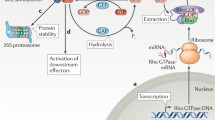Abstract
Rho GTPases act as molecular switches to control many basic cellular activities that are also critical to the specialized functions of phagocytic leukocytes. Our laboratory has studied the regulation of Rho GTPase function, how these GTPases interact with specific effectors to modulate cell function, and how these events are coordinated in the stimulated cell. Areas of major interest include NADPH oxidase regulation by Rac2, Rac- and Cdc42-mediated control of the actin-myosin cytoskeleton via p21-activated kinase (PAK), and modulation of the apoptotic program by Rho GTPases and PAK.
Similar content being viewed by others
References
Bokoch GM, Der CJ: Emerging concepts in the ras superfamily of GTP-binding proteins. FASEB J 1993;7:750–759.
Bokoch G: Interplay between Rasrelated and heterotrimeric GTP-binding proteins: lifestyles of the BIG and little. FASEB J 1996; 10:1290–1295.
Bokoch GM: Chemoattractant signaling and leukocyte activation. Blood 1995;86:1649–1660.
Bokoch GM, Parkos CA: Identification of novel GTP binding proteins in the human neutrophil. FEBS Lett 1988;227:66–70.
Bokoch GM, Parkos CA, Mumby SM, et al.: Purffication and characterization of the 22,000-Dalton GTP-binding protein subunit for ADP-ribosylation by Botulinum Toxin, G22K. J Biol Chem 1988; 263:16,744–16,749.
Knaus UG, Heyworth PG, Evans T, et al.: Regulation of phagocyte oxygen radical production by the GTP-binding protein Rac2. Science 1991;254: 1512–1515.
Bokoch GM: Regulation of the phagocyte respiratory burst by small GTP-binding proteins. Trends Cell Biol 1995;5:109–113.
Zhou K, Wang Y, Gorski JL, et al.: Guanine nucleotide exchange factors regulate specificity of downstream signaling from Rac and Cdc42. J Biol Chem 1998;273:16,782–16,786.
DeLeo FR, Quinn MT: Assembly of the phagocyte NADPH oxidase: molecular interactions of oxidase proteins. J Leukocyte Biol 1996; 60:677–691.
Dorseuil O, Vazquez A, Lang P, et al.: Inhibition of superoxide production in B lymphocytes by Rac antisense oligonucleotides. J Biol Chem 1992;267:20,540–20,542.
Quinn MT, Evans T, Loetterle LR, et al.: Translocation of Rac correlates with NADPH oxidase activation: evidence for equimolar translocation of oxidase components. J Biol Chem 1993;268: 20,983–20,987.
Dorseuil O, Quinn MT, Bokoch GM, et al.: Dissociation of Rac translocation from p47plux/p67plux movements in human neutrophils by tyrosine kinase inhibitors. J Leukocyte Biol 1995;58: 108–113.
Benard V, et al.: Characterization of Rac and Cdc42 activation in chemoattractant-stimulated human neutrophils using a novel assay for active GTPases. J Biol Chem 1999; 274:13198–13204.
Knaus UG, Bokoch GM: The p21 Rac/Cdc42-activated kinases (PAKs). Int J Biochem Cell Biol 1998;30:857–862.
Daniels RH, Bokoch GM: p21-activated protein kinase: a crucial component of morphological signaling? Trends Biochem Sci 1999;24:350–355.
Zenke FT, King CC, Bohl BP, et al.: Identification of a central phosphorylation site in p21-activated kinase regulatingautoin-hibition and kinase activity. J Biol Chem 1999;274:32565–32573.
Sells MA, Knaus UG, Bagrodia S, et al.: Human p21-activated kinase (Pak1) regulates actin organization in mammalian cells. Curr Biol 1997;7:202–210.
Bokoch GM, Wang Y, Bohl BP, et al.: Interaction of the Nck adapter protein with p21-activated kinase (PAK1). J Biol Chem 1996;271:25746–25749.
Dharmawardhane S, Sanders LC, Martin SS, et al.: Localization of p21-activated kinase 1 (PAK1) to pinocytic vesicles and corticalactin structures instimulated cells. J Cell Biol 1997;138:1265–1278.
Manser E, Huang HY, Loo TH, et al.: Expression of constitutively active alpha-PAK reveals effects of the kinase on actin and focal complexes. Mol Cell Biol 1997; 17:1129–1143.
Abo A, Qu J, Cammarano MS, et al.: PAK4, a novel effector for Cdc42Hs, is implicated in the reorganization of the actin cytoskeleton and in the formation of filopodia. EMBO J 1998;17: 6527–6540.
Hing H, Xiao J, Harden N, et al.: Pak functions down stream of Dock to regulate photo-receptor axon guidance in Drosophila. Cell 1999;97:853–863.
Sells MA, Boyd JT, Chernoff J, et al.: p21-activated kinase 1 (Pak1) regulates cell motility in mammalian fibroblasts. J Cell Biol 1999;145:837–849.
Kiosses WB, Daniels RH, Otey C, et al.: A role for p21-activated kinase in endothelial cell migration. J Cell Biol 1999;147: 831–844.
Daniels RH, Hall P, Bokoch GB, et al.: Membrane targeting of p21-activated kinase 1 (PAK1) induces meutrite outgrowth from pc12 cells. EMBO J 1998;17: 754–764.
Manser E, Loo TH, Koh CG, et al.: PAK kinases are directly coupled to the PIX family of nucleotide exchange factors. Mol Cell 1998; 1:183–192.
Bagrodia S, Taylor SJ, Jordan KA, et al.: A novel regulator of p21-activated kinases. J Biol Chem 1998;273:23633–23636.
Allen KM, Gleeson JG, Bagrodia S, et al.: PAK3 mutation in nonsyndromic X-linked mentalretardation. Nat Genetics 1998;20:25–30.
Sanders LC, Matsumura F, Bokoch GM, de Lanerolle P: Inhibition of myosin light chain kinase by p21-activated kinase. Science 1999;283:2083–2085.
Stanyon CA, Bernard O: LIM-kinasel. Int J Biochem Cell Biol 1999;31:389–394.
Arber S, Barbayannis FA, Hanser H, et al.: Regulation of actin dynamics through phosphorylation of cofillin by LIM-kinase. Nature 1998;393:805–809.
Yang N, Higuchi O, Ohashi K, et al.: Cofilin phosphorylation by LIM-kinase 1 and its role in Rac-mediated actin reorganization. Nature 1998;393:809–812.
Edwards DC, Sanders LC, Bokoch GM, et al.: Activation of LIM-kinase by Pakl couples Rac/Cdc42 GTPase signalling to actin cytoskeletal dynamics. Nat Cell Biol 1999;1:253–259.
Wyllie H: Apoptosis. Br Med Bull 1997;53(3):451–685.
Subauste MC, Von Herrath M, Benard V, et al.: Rho family proteins modulate rapid apoptosis induced by cytotoxic T lymphocytes and Fas. J Biol Chem 2000, in press.
Na S, Chuang TH, Turi TG, et al.: D4-GDI, a substrate of CPP32 is proteolyzed during Fas-induced apoptosis. J Biol Chem 1996; 271:11209–11213.
Rudel T, Zenke FT, Chuang TH, et al.: p21-activated kinase (PAK) is required for Fas-induced JNK activation in Jurkat cells. J Immunol 1998;160:7–11.
Chuang T-H, Hahn KM, Lee JD, et al.: The small GTPase Cdc42 initiates an apoptotic signaling pathway in Jurkat T lymphocytes. Mol Biol Cell 1997;8:1687–1698.
Zhang S, Han J, Sells MA, et al.: Rho family GTPases regulate p38 MAP kinase through the down-stream mediator Pakl. J Biol Chem 1995;270:23934–23936.
Schürmann A, Mooney AF, Sanders LC, et al.: p21-activated kinase 1 phosphorylates the death agonist Bad and protects cells from apoptosis. Mol Cell Biol, 2000;20:
Author information
Authors and Affiliations
Rights and permissions
About this article
Cite this article
Bokoch, G.M. Regulation of cell function by rho family GTPases. Immunol Res 21, 139–148 (2000). https://doi.org/10.1385/IR:21:2-3:139
Issue Date:
DOI: https://doi.org/10.1385/IR:21:2-3:139



